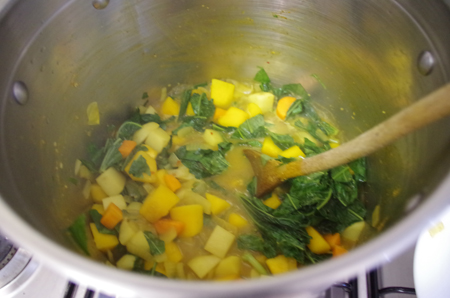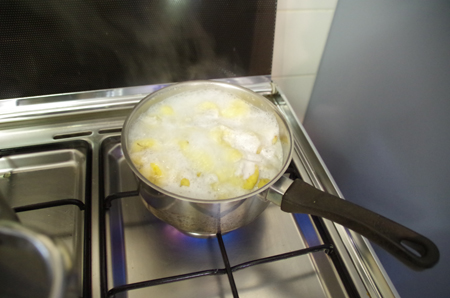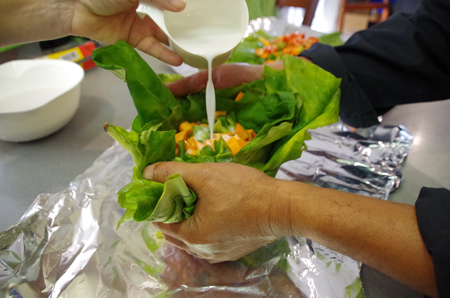My mum and I have been learning Tonga for the last few months. Our Tongan teacher Taua suggested that as food is such an important part of Tongan culture we should have a lesson where we cook Tongan food. We made lū moa (chicken wrapped in taro leaves), vesitapolo kale (vegetable curry), ufi (yam), and vai siaine (bananas boiled in coconut cream). Because this cooking was part of a Tongan lesson, I’m going to try to write up this post in Tongan, and English.
Me’akai (food) [all measurements are approximate because nothing was measured)
Lū moa
- 400g chicken thigh (moa)
- 2 carrots (kaloti)
- 2 capsicum (polo)
- 1 tomato (tomate)
- 1 onion (onioni)
Vesitapolo kale
- 400g of pumpkin (hina)
- 5 potatoes (potate)
- 2 carrots (kaloti)
- 2 onions (onioni)
- 3 tbsp of ghee or oil (lolo)
- 2 tsp of garlic (kaliki)
- 2 tsp of ginger (sinesa)
- 1/2 tsp of chili (polo fifisi)
- Sapaisi (spices)
- 1 tsp of cumin
- 1 tsp of turmeric
- 1 tsp of garam masala
- 1 tsp of tea masala
- 1 tsp of coriander
Vai Siaine
- 4 bananas (siaine)
- 3-4 cups of coconut cream (niu)
Lū moa
Te ke ‘uluaki tū lū, foki tuku ki he foila. Te ke tanaki e moa, onioni, kaloti, polo, mo tomate. Te ke foki tanaki niu, pea kofu lū. Te ke foki ta’o ‘i he oveni, pea te ke foki talitali.

Niu (‘i he lū moa)
Te ke ‘uluaki hoka niu, pea te ke foki vau niu, pea foki tanaki vai mafana. Tatali si’i. Te ke foki tatau niu.
Kale vesitapolo
Te ke ‘uluaki tele pateta mo hina. Te ke foki hifi onioni, kaliki, hina, poteta, sinisa, polo fifisi, sapaisi, mo pele. Te ke haka kale kae’oua moho. Te ke haka laisi mo kola mo coriander.

Vai siaine
Te ke ‘uluaki fohi siaine momoho. Te ke foki paki ki he kulo, pea te ku tanaki niu. Te ke foki haka ‘i he sitou kae’oua moho.

Ufi
Te ke haka ufi kae’oua moho.
Taimi Kai!!
I’m relatively new to learning Tongan, so the Tongan versions of the recipes are much more simplistic than the English. But I’ll make the English ones more concise to match. Apologies for any mistakes in the Tongan versions of the instructions
Lū moa (chicken wrapped in taro leaves)
If you don’t have taro leaves wherever you are, you can use large spinach leaves, or even cabbage. Layer the leaves on top of each other to create the ‘wrapping’. Put the chicken, carrot, tomato, capsicum, onion, and whatever else you like in the centre. Fold the edges of the leaves up to form a sort of pouch then pour the coconut cream in until the veggies are mostly covered.

Then wrap the whole thing in foil, and place it on a baking tray. Normally you would cook lū in a umu (traditional pit oven), but we cooked ours in a moderate oven.
To make the coconut cream from scratch you scrape the coconut flesh out, and mix it with some warm water. Leave it to sit for a little while. Then grab a cloth and grab a handful of shredded coconut out of the bowl then squeeze the coconut until all the cream has come out. Repeat this until all of the coconut flesh is out of the bowl. To clean out any last bits of flesh, strain it through the cloth into a bowl.
Kale vesitapolo (vegetable curry)
This was just a basic vegetable curry. Peel and chop potatoes, pumpkin, carrot, and onion. Fry the onions, ginger, and garlic in ghee or vegetable oil until soft. Add the potatoes, pumpkin, and carrot, and shred in the spinach. Add about a cup of hot water and bring to the boil. Simmer until the veggies go soft, then serve with rice. I made lime and coriander rice.
Vai siaine (bananas cooked in coconut cream)
Vai siaine is my new favourite dessert. It is so simple, and relatively healthy. Peel your ripe bananas then put them in a pot, and cover them with coconut cream. Bring to the boil, then simmer until the banana is mushy, and the coconut cream has taken on the banana’s sweetness.

wow….. all looks soo lovely Jess…..
LikeLiked by 1 person
Jess totoatu hoo lea fakaTonga. Im very proud of you. Ofa atu
LikeLike
Malo lahi aupito Taua. Ofa atu.
LikeLike